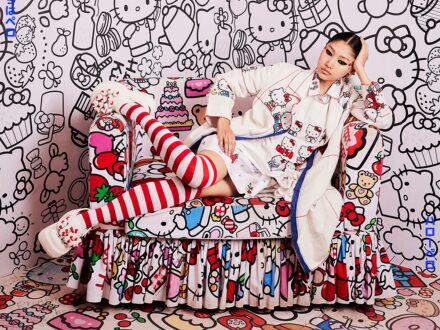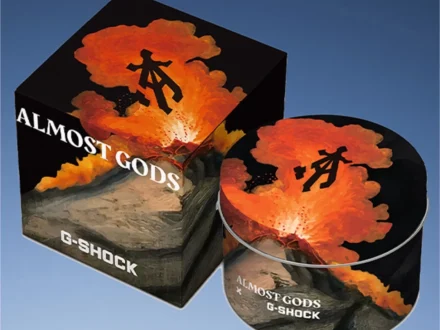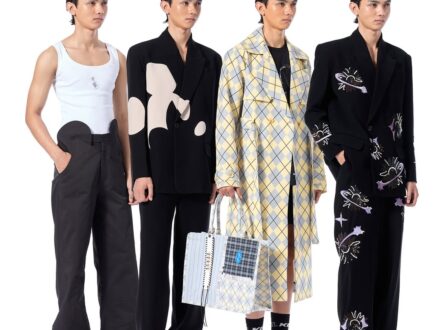Beyond Borders
How Collaborations With Global Brands Take Shape
Founders of five brands take us behind the scenes of their recent collaborations with global brands.
Aneeth Arora of péro
Kanika Goyal of KGL
Mriga Kapadiya of NorBlack NorBlack
Dhruv Khurana of Almost Gods
Harshit Agarwal of Pistabarfi
Over the last decade, India’s creative community has stepped firmly into the spotlight, with a growing number of artists and designers making their mark both at home and on global stages. Today, as momentum builds, the homegrown industry is not only finding new visibility but also being recognised for its unique design language and capacity for innovation—qualities set to evolve further rather than fade away as a passing fad. Along the way, this shift has also opened doors to large-scale collaborations with global names such as Nike, Puma, G-SHOCK, Hello Kitty, and Disney.
“I really don’t think there’s a one-size-fits-all formula. For us, it’s always been about doing what we genuinely believe in and having fun with it. That way, it never feels like we’re trying to impress anyone or follow a trend,”
- Harshit Agarwal, Founder- Pistabarfi

From First Conversations to Creative Synergy
While collaborations are quite well-known and mainstream for consumers today, for emerging brands and young creatives, it can still be a complex and layered journey to navigate. And in a landscape where both fresh brands and global players are becoming increasingly eager to partner, seeking fresh audiences, new markets and creative dialogues that push boundaries, the real question is what does it take for a brand to find the right partner, and enter a collaboration? Behind the scenes, where do the first conversations begin, who takes the initial steps, what are the key learnings along the way, and, in hindsight, what approaches could have been different? Blur The Border takes a closer look. Ahead, we speak to five founders: Aneeth Arora of péro, Kanika Goyal of Kanika Goyal Label, Mriga Kapadiya of NorBlack NorWhite, Dhruv Khurana of Almost Gods, and Harshit Agarwal of Pistabarfi, who weigh in on this with a unique insight shaped by their individual experiences. However, there is shared wisdom among all: building an unshakable identity of your own and recognising that shared values are the glue that holds a collaboration together.
As a first step, NorBlack NorWhite co-founder Mriga Kapadiya recalls the importance of taking time to build a clear brand identity long before their collaboration with Nike, which showcased the label’s celebrated take on regional crafts in a limited collection of sportswear staples. “We’ve spent 15 years building and rebuilding all aspects of our world, and it felt like the right moment to execute this collaboration without compromising our identity. It’s noisy out there, so be clear, so nothing can shake you,” she notes.
Founders Dhruv Khurana of Almost Gods and Kanika Goyal of KGL emphasise similar viewpoints on shared values as one of the cornerstones of any collaboration. “Start by aligning on values before anything else. Aesthetic synergy and amplified reach are important, but it’s shared belief systems that make the collaboration durable. When both brands are clear about what they stand for, the rest of the process feels intentional from start to finish,” says Dhruv, whose brand Almost Gods became the first Indian collaborator with G-Shock through a 250-piece limited-edition collection of watches inspired by the raw power of a volcanic eruption. In context to KGL’s collaboration with Disney, which gave Mickey Mouse fans worldwide a 114-piece capsule collection in the label’s edgy Indian spirit, Kanika shares, “The most important thing is choosing the right partner–whose values, ethos, and creative language align with yours. The synergy has to be genuine, not forced.” She continues, “Once that’s in place, the next big challenge is maintaining the integrity of both worlds without diluting either. It’s about finding that sweet spot where your vision and theirs can coexist in a way that feels fresh and cohesive.”
Aneeth Arora, founder of péro, builds on these insights. Reflecting on her label’s collaboration with Hello Kitty, which produced over 100 designs blending cottagecore and kawaii styles across womenswear, menswear, and kidswear, she emphasises that a collaboration must also be driven by deeper intent rather than market optics. She says, “Focus on creating something that tells a shared story. Invest time in research, understanding the collaborator’s world, and find ways to bring your unique craft or perspective to the table. When both brands connect emotionally and creatively, the result resonates far beyond the product.”
“Focus on creating something that tells a shared story. Invest time in research, understanding the collaborator’s world, and find ways to bring your unique craft or perspective to the table. When both brands connect emotionally and creatively, the result resonates far beyond the product.”
- Aneeth Arora, Founder-Pero

How Clarity and Authenticity Attract the Right Collaborators
Meanwhile, Harshit Agarwal, co-founder of Pistabarfi, offers a different take on this following their collaboration with Puma. It brought fashion and food culture together, pairing Puma’s Palermo sneaker launch with mithai packaging designed in the same colour palette. The result was a nostalgic yet contemporary collectable that spoke to sneaker enthusiasts and dessert lovers alike. For Harshit, it’s a reminder that collaborations don’t follow a linear path or a fixed rulebook. “I really don’t think there’s a one-size-fits-all formula. For us, it’s always been about doing what we genuinely believe in and having fun with it. That way, it never feels like we’re trying to impress anyone or follow a trend,” he says. But eventually, it is the foundations that quietly do the heavy lifting over time. “Be clear about what you’re doing and why you’re doing it. Even if you’re still figuring it out, enjoy the process.
When your work reflects something honest or original, the right people will find their way to you. That’s when collaborations feel real and exciting, not just something you’re chasing for the name.” After identity, values, intent, and authenticity are in place, it also comes down to how the collaboration is presented to the audience. Kanika points out further, “Never underestimate the power of visual communication. Your imagery, your storytelling, and your tone become powerful tools in helping audiences navigate and understand the collaboration. Building a strong visual vocabulary is just as important as the product itself. It’s what transforms a partnership into a narrative.”
But then, where does it all begin? Who takes the first steps? For many brands, it wasn’t born from actively chasing such partnerships. Instead, they took shape organically, with global names drawn toward each of their unique design language, a quality that has perhaps become one of the strongest suits of homegrown labels today. Aneeth recalls, “Sanrio approached us during Hello Kitty’s 50th anniversary, coinciding with Péro’s 15th year.” Similarly, Nike had reached out to NorBlack NorWhite in 2023. “They were interested in building a relationship and supporting our work,” emphasises Mriga. Dhruv looks back, too.
“G-Shock has been this voice in the cultural zeitgeist globally for the longest time; the idea ignited the 5-year-old in us,” says Dhruv. For Harshit, too, “It came about quite organically. We were working on a new drop for Pistabarfi, something fun, a little irreverent, rooted in nostalgia but designed in a more playful, accessible way. Around the same time, Puma was gearing up for new Palermo drops,” he shares, adding that the global activewear giant was looking to collaborate with homegrown brands that aligned with their ethos.

"The key was figuring out the story we wanted to tell. It had to speak to the brand, convey that sense of power and yet feel special in the context of G-SHOCK’s global catalogue and collaborations library,”
- Dhruv Khurana, Founder-Almost Gods
How Global Collaborations are Evolving to Engage with India's Creative Depth
What’s equally fascinating beyond the initial steps and the broader arc of these recent collaborations is the clear shift in how global brands are now engaging with India. They aren’t just tapping into ‘Indian aesthetics’, but also acknowledging the multifaceted design, language, and storytelling that brands today have to offer. Although NorBlack NorWhite’s collaboration with Nike showcased the label’s celebrated use of traditional Indian dyeing techniques, its true intent was to explore something deeper. “Nike offered us the chance to collaborate on their first women’s collection coming out of India,” shares Mriga. “Before we even began designing, they took us on an incredible retreat to Australia with 30 other artists and designers from around the world who were also part of the Nike family,” signalling that more than just design, it was about building a creative community.”
Kanika Goyal Label’s collaboration took a more personal turn, rooted in the collective nostalgia surrounding Mickey Mouse, a character whose cultural resonance spans generations. “What excited me most was placing Mickey against the vibrancy and chaos of Indian craft and storytelling. For me, Mickey and his friends weren’t just animated characters from childhood—they were emotional placeholders, symbols of joy, mischief, and comfort. This collaboration was about creating something that feels visually unexpected yet deeply rooted in where I come from,” she shares.
Reimagining traditional mithai without being stuck in convention or altering its original essence is what intrigued Puma to approach Pistabarfi.“Both brands shared a similar spirit, taking something classic and giving it a fresh, cool spin.” Referring to their Mysore Pak in a can and Aam Papad strips for this collaboration, he continues, “Our products already existed. The only thing we adapted was the packaging to match the Palermo sneaker colours. That meant tweaking materials, finishes, and getting the visual tone right. “We’re building a new way for people to experience mithai. The Puma collab was just one example of how that idea can live in different contexts.”
Even then, what we see is only the surface of a much deeper creative exchange. While bringing a collaboration to life involves similar stages, including extensive research, concept building, design development, and constant refinement, the real advantage lies in knowing there’s no fixed playbook. Some may unfold over years, others in just a few months. But what makes them work is not speed; it's the message you are putting out. “The entire process took about a year, from our first internal brainstorming sessions to getting final approvals from the G-SHOCK global team. The key was figuring out the story we wanted to tell. It had to speak to the brand, convey that sense of power and yet feel special in the context of G-SHOCK’s global catalogue and collaborations library,” says Dhruv. For Pèro, although the entire process spanned nearly two years, “A focused eight-month phase was dedicated to developing over 100 designs. We began with research and concept building, aligning Hello Kitty’s playful charm with péro’s artisanal ethos, perfecting details through embroidery and appliqué techniques,” says Aneeth.
Interestingly, the Pistabarfi x Puma partnership moved quickly, over 2 months, but with equal attention to detail. “Once we had a rough idea of the products, the packaging discussions began—bringing the Palermo colours into our design and figuring out the Puma x Pistabarfi logo in Devanagari, which went through several iterations,” says Harshit. “Then it was about refining the products and packaging—focusing on Aam Papad and Mysore Pak, perfecting the details from the paper and foil to how the pack opens, and finally, visually blending the ethos of Puma and Pistabarfi into something cohesive and fun.”
“There are a lot of different respective roles, a lot of time zones, a lot of regions to consider, as this was a global launch and the army of humans it takes to make all decisions from small to big. Overall, we learned the timeline challenges that can come with operating at such a large scale; however, the impact a project has because of its scale is unmatched.”
- Mriga Kapadia, Founder-NorBlack NorWhite

Scaling Creativity: Lessons from Going Global
For young brands aspiring for global collaborations, founders look back on what it takes to operate at scale. Kanika describes it as "a fascinating window into the inner workings of the Disney universe—its storytelling structure, its visual discipline, and its global resonance." One of the key highlights for the founder was realising the emotional depth of the Disney brand across generations. "We weren’t just designing for die-hard fans, but also for people who had once felt connected to those characters and might have drifted away. We wanted the collection to speak to both—those who love Disney with all their heart, and those who remember it fondly but connect more with a modern reinterpretation."
For both Pèro and Almost Gods, it led to fresh new insights about their respective consumer base. “It reaffirmed how much our audience leans into intention. The more we revealed about the story behind the design, the more it resonated. People didn’t just want to see the product; they wanted to understand it and connect with it,” says Dhruv. Echoing the sentiment, Aneeth shares, “We discovered how versatile our audience is, embracing both subtle and playful designs and learned to navigate strict brand guidelines while staying true to our creative voice. Most importantly, it reinforced that a collaboration rooted in shared values can create an emotional connection far beyond the garments.”
For Harsh, “The primary difference was the structured, multi-level approval process that comes with working with a large brand versus an individual," he notes. But in the end, fundamentals should remain intact, “Clear communication, meeting timelines, and delivering a high-quality product. It’s about doing the basics well and staying consistent,” he emphasises. On a similar note, Mriga expands further, “There are a lot of different respective roles, a lot of time zones, a lot of regions to consider, as this was a global launch and the army of humans it takes to make all decisions from small to big. Overall, we learned the timeline challenges that can come with operating at such a large scale; however, the impact a project has because of its scale is unmatched.”

“The most important thing is choosing the right partner–whose values, ethos, and creative language align with yours. The synergy has to be genuine, not forced.”
- Kanika Goyal, Founder-Kanika Goyal Label
Beyond the Collaborations: Lessons in Hindsight
Even as the outcomes bring a sense of pride, hindsight naturally invites reflection on what might have been done differently. For some, it was about allowing more innovation and streamlining the process, while for others, it was prioritising marketing. “This would have given us more time to explore experimental craft techniques, like weaving or 3D surface textures, which we had to simplify due to tight timelines. It showed us the impact of creating an experience. Next time, we’d integrate interactive elements — installations, digital experiences, playful narratives — from the start, to push the creative and operational boundaries even further,” says Aneeth.
Dhruv reflects on this as an inevitable part of any meaningful project, “You’ll always look back and find things you might refine — whether that’s streamlining the process, building more touchpoints, or thinking bigger in execution. Overall, we’re proud of what both teams created together. The collaboration gave our community something that feels true to both brands. The love the collection received made it all worth it.” Meanwhile, Mriga shares that the importance of digital visibility matters more than ever “Spend more time on the marketing, PR, and distribution strategies,” she says.
What ultimately becomes clear through these conversations is that the new wave of collaborations is no longer about borrowing ‘aesthetics’ but about building shared worlds, and this is what will lead the way forward. They demand clarity of identity, patience with process, and an openness to experiment. For young homegrown brands, the message is unmistakable: when identity and intent are strong, the right partners and opportunities follow. These are encouraging signs of a community growing more confident, shaping collaborations that blur borders, carry India’s creative language onto a global stage, and leave us eager for what’s on the way.